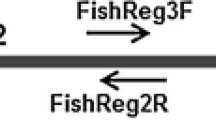Abstract
The international trade in ornamental aquatic organisms represents an important vector in the spread of invasive species worldwide, but the accurate identification of imported organisms as part of a biosecurity surveillance program offers an opportunity to mitigate potential problems. Species level identification is historically conducted visually, and more recently, with the use of DNA barcoding. However, new diagnostic methods targeting extracellular environmental DNA (eDNA) can offer advantages over these approaches, being non-destructive and potentially more sensitive at low population densities of target organisms (e.g. in mixed consignments). Despite their recent introduction, techniques utilising eDNA are quickly becoming recognised as an important tool for invasion biologists and ecosystem managers. Here, we present a model for the development of a biosecurity protocol for ornamental fish identification using degraded eDNA molecules in water. We demonstrate how a DNA barcode reference library can be mined for informative short-length markers, and report repeatable and accurate detection at low densities of the target species. This study represents a framework for biosecurity agencies to develop eDNA procedures as an innovative management technique for routine surveillance of high risk imports. Future up-scaling of the method will open up prospects for long term monitoring of entire quarantine facilities for a variety of harmful species.

Similar content being viewed by others
References
Andersen K, Bird KL, Rasmussen M, Haile J, Breuning-Madsen H, Kjaer KH, Orlando L, Gilbert MTP, Willerslev E (2012) Meta-barcoding of ‘dirt’ DNA from soil reflects vertebrate biodiversity. Mol Ecol 21:1966–1979
Boyer S, Brown SDJ, Collins RA, Cruickshank RH, Lefort MC, Malumbres-Olarte J, Wratten SD (2012) Sliding window analyses for optimal selection of mini-barcodes, and application to 454-pyrosequencing for specimen identification from degraded DNA. PLoS ONE 7:e38,215
Brown SDJ, Collins RA, Boyer S, Lefort MC, Malumbres-Olarte J, Vink CJ, Cruickshank RH (2012) Spider: an R package for the analysis of species identity and evolution, with particular reference to DNA barcoding. Mol Ecol Resour 12:562–565
Chang AL, Grossman JD, Spezio TS, Weiskel HW, Blum JC, Burt JW, Muir AA, Piovia-Scott J, Veblen KE, Grosholz ED (2008) Tackling aquatic invasions: risks and opportunities for the aquarium fish industry. Biol Invasions 11:773–785
Cole B, Tamaru CS, Bailey R, Brown C, Ako H (1999) Shipping practices in the ornamental fish industry. Cent Trop Subtrop Aquacult Publ 131:1–22
Collins RA, Armstrong KF, Meier R, Yi Y, Brown SDJ, Cruickshank RH, Keeling S, Johnston C (2012) Barcoding and border biosecurity: identifying cyprinid fishes in the aquarium trade. PLoS ONE 7:e28,381
Copp GH, V L, Mumford J, Fenwick GV, Godard MJ, Gozlan RE (2009) Calibration of FISK, an invasiveness screening tool for nonnative freshwater fishes. Risk Anal 29:457–467
Darling JA, Mahon AR (2011) From molecules to management: adopting DNA-based methods for monitoring biological invasions in aquatic environments. Environ Res 111:978–988
Dejean T, Valentini A, Duparc A, Pellier-Cuit S, Pompanon F, Taberlet P, Miaud C (2011) Persistence of environmental DNA in freshwater ecosystems. PLoS ONE 6:e23,398
Derraik JGB, Phillips S (2010) Online trade poses a threat to biosecurity in New Zealand. Biol Invasions 12:1477–1480
Duggan IC (2010) The freshwater aquarium trade as a vector for incidental invertebrate fauna. Biol Invasions 12:3757–3770
Ficetola GF, Miaud C, Pompanon F, Taberlet P (2008) Species detection using environmental DNA from water samples. Biol Lett 4:423–425
Goldberg CS, Pilliod DS, Arkle RS, Waits LP (2011) Molecular detection of vertebrates in stream water: a demonstration using rocky mountain tailed frogs and idaho giant salamanders. PLoS ONE 6:e22,746
Hajibabaei M, Singer GAC, Clare EL, Hebert PDN (2007) Design and applicability of DNA arrays and DNA barcodes in biodiversity monitoring. BMC Biol 5:1–7
Hensen RR, Ploeg A, Fosså SA (2010) Standard names for freshwater fishes in the ornamental aquatic industry. Ornamental Fish International, Maarssen
Jerde CL, Mahon AR, Chadderton WL, Lodge DM (2011) “Sight-unseen” detection of rare aquatic species using environmental DNA. Conserv Lett 4:150–157
Kemp BM, Smith DG (2005) Use of bleach to eliminate contaminating DNA from the surface of bones and teeth. Forensic Sci Int 154:53–61
Le Vin AL, Adam A, Tedder A, Arnold KE, Mable BK (2011) Validation of swabs as a non-destructive and relatively non-invasive DNA sampling method in fish. Mol Ecol Resour 11:107–109
McDowall RM (2004) Shoot first, and then ask questions: a look at aquarium fish imports and invasiveness in New Zealand. NZ J Mar Freshw Res 38:503–510
Meyerson LA, Reaser JK (2002) Biosecurity: moving toward a comprehensive approach. BioScience 52:593–600
Ploeg A, Fosså SA, Bassleer G, Willis S, Lim LL (2012) International transport of live fish in the ornamental aquatic industry. Ornamental Fish International, Maarssen
Qu W, Shen Z, Zhao D, Yang Y, Zhang C (2009) MFEprimer: multiple factor evaluation of the specificity of PCR primers. Bioinformatics 25:276–278
R Development Core Team (2012) R: a language and environment for statistical computing. Vienna, Austria. http://www.r-project.org
Rozen S, Skaletsky H (2000) Primer3 on the WWW for general users and for biologist programmers. Methods Mol Biol 132:365–386
Thomsen PF, Kielgast J, Iversen LL, Wiuf C, Rasmussen M, Gilbert MTP, Orlando L, Willerslev E (2012) Monitoring endangered freshwater biodiversity using environmental DNA. Mol Ecol 21:2565–2573
Whittington RJ, Chong R (2007) Global trade in ornamental fish from an Australian perspective: the case for revised import risk analysis and management strategies. Prev Vet Med 81:92–116
Willerslev E, Cooper A (2005) Ancient DNA. Proc R Soc B Biol Sci 272:3–16
Acknowledgments
We thank MPI Biosecurity New Zealand for providing water samples from Danio rerio shipments, and three reviewers for suggesting improvements to earlier versions of the manuscript. RC was funded by a MPI Biosecurity New Zealand scholarship.
Author information
Authors and Affiliations
Corresponding author
Electronic supplementary material
Rights and permissions
About this article
Cite this article
Collins, R.A., Armstrong, K.F., Holyoake, A.J. et al. Something in the water: biosecurity monitoring of ornamental fish imports using environmental DNA. Biol Invasions 15, 1209–1215 (2013). https://doi.org/10.1007/s10530-012-0376-9
Received:
Accepted:
Published:
Issue Date:
DOI: https://doi.org/10.1007/s10530-012-0376-9




